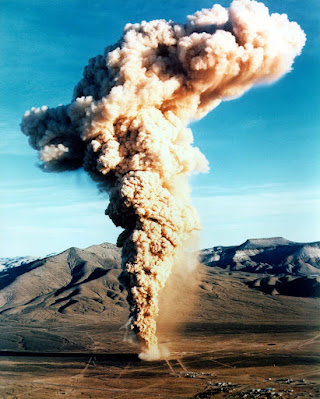Kim Jong-un, the Nobel, and the Western Shoshone
 |
| Accidental release from 1970 underground test. |
This article appeared on Rural America In These Times in 2017. For more on topics like this, see my book, American Apartheid: The Native American Struggle...
Kim Jong-un can relax! We’ve already nuked ourselves! A lot!
The Nobel Committee’s announcement that the International Campaign to Abolish Nuclear Weapons has received this year’s Peace Prize has thrown a spotlight on U.S. nuclear policy. Nearly 1,000 nuclear devices have been detonated above and below ground at the Nevada Test Site since it was established in 1951.
As I recently reported in Rural America In These Times, this makes the Western Shoshone, within whose treaty lands the site lies—and by extension, the rest of us—arguably the most bombed nation on earth. And now, the Trump administration wants to ramp up the radioactive poisons in the area.
In June, Department of Energy (DOE) Secretary Rick Perry suggested using the test site, now called the Nevada National Security Site, as an interim waste dump. At the same time, Perry would reopen licensing procedures for nearby Yucca Mountain, with a view toward making the mountain— revered as a sacred site by area tribes—the permanent repository for spent nuclear fuel. The mountain would be full up with just a fraction of the nation’s radioactive waste almost immediately after it opened.
The waste would travel to Nevada via roads and railroads throughout the country. Does anybody want this highly dangerous material traveling through their community?, asks Timbisha Shoshone tribal historic preservation officer Barbara Durham, whose people live west of the mountain.
Once the waste arrived, its home would be deep inside the earthquake-prone mountain. The DOE’s Final Environmental Impact Statement (FEIS) for the project admits that Yucca Mountain may be shaken by “ground motion” and that “beyond-the-design” events could collapse the waste facility.
There is a bright spot: According to the FEIS, Yucca Mountain is “highly unlikely” to erupt as a volcano.
The Timbisha Shoshone government blasted Perry’s proposal, citing the groundwater contamination that the Nuclear Regulatory Commission has said will likely occur, even without any earthquakes. Timbisha Chairman George Gholson told the Department of Energy “affronts the Timbisha’s way of life, is disrespectful to cultural beliefs, and constitutes an environmental justice infringement on the rights of a sovereign nation.” Native activists, notably Tom Goldtooth from Indigenous Environmental Network, also excoriated the idea, along with Nevada’s governor, other state officials and Congressional delegation.
The Timbisha Shoshone live west of the mountain and test site and still feel the effects of the detonations and leaks that have occurred there since 1951, according to Durham. She points out that radiation has become part of large areas, redistributed via forces such as the winds, the aquifers and the transpiration cycle. “Everything is connected,” says Durham.
Text c. Stephanie Woodard; photo courtesy National Nuclear Security Administration/Nevada Site Office.
Kim Jong-un can relax! We’ve already nuked ourselves! A lot!
The Nobel Committee’s announcement that the International Campaign to Abolish Nuclear Weapons has received this year’s Peace Prize has thrown a spotlight on U.S. nuclear policy. Nearly 1,000 nuclear devices have been detonated above and below ground at the Nevada Test Site since it was established in 1951.
As I recently reported in Rural America In These Times, this makes the Western Shoshone, within whose treaty lands the site lies—and by extension, the rest of us—arguably the most bombed nation on earth. And now, the Trump administration wants to ramp up the radioactive poisons in the area.
In June, Department of Energy (DOE) Secretary Rick Perry suggested using the test site, now called the Nevada National Security Site, as an interim waste dump. At the same time, Perry would reopen licensing procedures for nearby Yucca Mountain, with a view toward making the mountain— revered as a sacred site by area tribes—the permanent repository for spent nuclear fuel. The mountain would be full up with just a fraction of the nation’s radioactive waste almost immediately after it opened.
The waste would travel to Nevada via roads and railroads throughout the country. Does anybody want this highly dangerous material traveling through their community?, asks Timbisha Shoshone tribal historic preservation officer Barbara Durham, whose people live west of the mountain.
Once the waste arrived, its home would be deep inside the earthquake-prone mountain. The DOE’s Final Environmental Impact Statement (FEIS) for the project admits that Yucca Mountain may be shaken by “ground motion” and that “beyond-the-design” events could collapse the waste facility.
There is a bright spot: According to the FEIS, Yucca Mountain is “highly unlikely” to erupt as a volcano.
The Timbisha Shoshone government blasted Perry’s proposal, citing the groundwater contamination that the Nuclear Regulatory Commission has said will likely occur, even without any earthquakes. Timbisha Chairman George Gholson told the Department of Energy “affronts the Timbisha’s way of life, is disrespectful to cultural beliefs, and constitutes an environmental justice infringement on the rights of a sovereign nation.” Native activists, notably Tom Goldtooth from Indigenous Environmental Network, also excoriated the idea, along with Nevada’s governor, other state officials and Congressional delegation.
The Timbisha Shoshone live west of the mountain and test site and still feel the effects of the detonations and leaks that have occurred there since 1951, according to Durham. She points out that radiation has become part of large areas, redistributed via forces such as the winds, the aquifers and the transpiration cycle. “Everything is connected,” says Durham.
Text c. Stephanie Woodard; photo courtesy National Nuclear Security Administration/Nevada Site Office.

